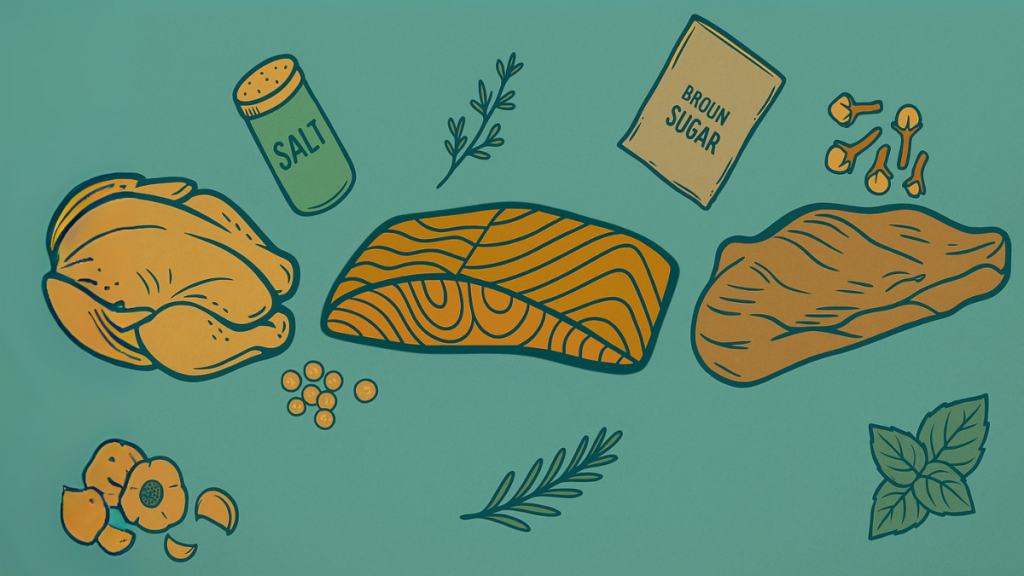
This was the question I used to ask myself hours—or sometimes just minutes—before a big cook. Brining meat sounds like a time-consuming extra step, and in some cases, like with salmon or smoked meats, it’s just the beginning of a long prep. But here’s the truth: taking just 5–10 minutes to start a quick brine made a huge difference in the final result. The flavor, moisture, and texture were leagues ahead of my usual attempts. So, should you brine your meat? Let’s break down why brining works, how to do it, what to use, and tips to level up your next meal.
What is a Brine and How Does It Work?
What is a Brine?
A brine is essentially a salty solution (sometimes with sugar and spices) that meat soaks in before cooking. It’s not just a marinade—it’s a method of changing how meat behaves when it cooks. By submerging meat in this mixture, you’re helping it absorb moisture and flavor from the inside out.
How Does A Brine For Meat Work?
Brining works through osmosis. The salt in the brine draws out some of the meat’s natural juices, which then get replaced with the flavored brine. This process tenderizes the meat and helps it stay juicy, even after hours on the grill, in the oven, or in the smoker. It’s why brined turkey often comes out miles better than the one you forgot in the fridge.
What Can I Use And How Long Does It Take?
Common Meat Brine Ingredients
At its core, a brine needs just two things: salt and water. From there, you can get creative. Add sugar for caramelization, herbs for aromatics, garlic or citrus for punch. Peppercorns, bay leaves, rosemary, brown sugar, even tea bags—there’s no one-size-fits-all recipe. Match your brine to the final flavor you’re going for.
How Long Should A Brine Take?
It depends on the cut. Thin cuts like pork chops may only need 30 minutes to an hour. Whole chickens or turkeys can benefit from 12 to 24 hours. The key is not to overdo it—too long in a salty bath can turn juicy into mushy. When in doubt, start small and scale up.
Dry Meat Brine vs. Wet Meat Brine
A wet brine involves submerging meat in liquid; a dry brine skips the water and uses salt and seasonings rubbed directly onto the surface. Both draw moisture into the meat and help with flavor, but dry brining is cleaner and often preferred for crispy skin—especially with poultry. Wet brines are great for full submersion and deeper penetration, like with large cuts or smoking prep.
Turkey Brine, Chicken Brine, Steak Marinade….
Different meats benefit from brining in their own unique ways. Turkey often needs a full 24-hour wet brine to soak in moisture—especially helpful for holiday roasts. Chicken, on the other hand, is more flexible. A quick wet brine boosts juiciness for roasting, while a dry brine helps crisp up the skin—perfect for oven or air fryer recipes. Steak generally doesn’t need a long soak due to its naturally robust flavor and fat content. But tougher cuts like flank or skirt steak can benefit from a short dry brine or a bold marinade, especially if you’re grilling or slicing thin for fajitas.
The type of meat, its size, and your cooking method all influence how you should brine—and for how long. In other words, EXPERIMENT!
Total Meat Brine Conclusion
Brining isn’t just an extra step—it’s a powerful cooking trick that can completely change the outcome of your meal. Whether you’re roasting a chicken, smoking a brisket, or prepping for Thanksgiving, understanding how to brine and when to use it can elevate your cooking from good to unforgettable. Start simple, experiment with ingredients, and watch your meals transform.

Leave a Reply